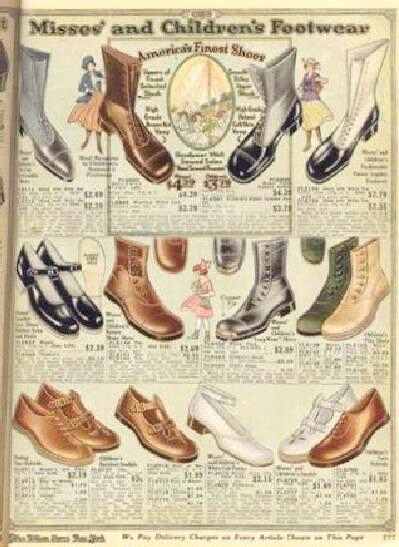
Figure 1.-- Here we see popular footwear styles for girls and younger boys in 1918. This was a page from the Charles William Company.


Figure 1.-- Here we see popular footwear styles for girls and younger boys in 1918. This was a page from the Charles William Company. |
We know virtualy nothing about the Charles William Company. A reader tells us that they were located in New York City. They produced a catalog similar to that of Seas and Wards. This page comes from the 1918 Charles William catalog. The shoes here are for "misses and children". That means that the were for older and younger girls and younger boys. THe Williams catalog offers a variety of shoe and sandal styles.
We know virtualy nothing about the Charles William Company. A reader tells us that they were located in New York City. They produced a catalog similar to that of Seas and Wards.
This page comes from the 1918 Charles William catalog.
The shoes here are for "misses and children". That means that the were for older and younger girls and younger boys. The sandals were made for boys and girls up to size 7. That would be age ?? years. Note that the strap shoes here were worn in the 1900s and 1910s by girls of different ages and younger boys. By the 1920s, however, they were seen as primarily a girl's shoe. Placement here with girls'styles probably is a reflection of this trend. Sandals were less definitively a girls style, but many boys did not like them and looked on them as a girls' shoe style.
THe Williams catalog offers a variety of shoe and sandal styles.
Most of the footwear here is high-top shoes done in varying styles. We believe these are all girls' styles. The prevalence of this style is an indicator that most girls still wore high-top shoes.
There are two low-top shoes shown at the bottom here. The lack of prominance is a reflection that they were not yet very common. The placement with sandals is an indicator that they were a sporty summer style, which is confirmed by the ad copy.
There are two styles if strap shoes offered here. We see both the ankle and instep strap style. The instep style is shown in black and white. The ankle strap is only shown in white, a reflectio of the styles declining popularity. These shoes were worn by girls of different ages and younger boys. They were at the time increasingly being seen as a girl's style. The single strap shoes were not given any name. Women's shoes with one or two straps were referred to as sandals. The only reference to "Mary Jane" is this catalog is an ankle strap shoe in sizes 2 to 7 (women's sizes). This is called a "one strap Mary Jane pump", but is in the women's shoe section.
the two bar t-strap is callled "Barefoot Sandal" as it was called into the 1950s or 1960s. The catalog offers three different styles of these double-bar sandals. Except the color difference, they look very similar. It is hard to tell from the image what the difference is. They look very similar to those shown in earlier years in the
Montgomery Ward's catalogs. The ad text for the sandals here reads, "
"Boys' or Women's . Sizes 2 1/2 to 7 $1.89"
"Boys' or Misses". Sizes 11 1/2 to 2 $1.59"
"Children's 8 1/2 to 11 $1.39"
"Infants' 5 to 8 $1.19"
"Fine quality tan Boarded leather Sandals the ideal low shoe for outdoor wear during the summer. They are bargain at our prices."
We believe the reference to "ideal low shoe" as opposed to the rather hot high top types at this time may be why this style spread so quickly in the early 1900s, especially after World War I. We are unsure just how popular these sandals were. Interestingly on the page devolted to juvenile suits in this same calalog, only one boy was shown wearing sandals. Much more popular, at least in the catalog lillustrations was strap shoes.
We note the use of the term "boarded leather" in the ad copy. We do not yet know what that meant. We would be interested in any insights readers might have. A reader writes, "I looked in the dictionary regarded "board". I didn't see anything listed for leather, but I saw reference to "cardboard". I wonder if "boarded leather" is a type of imitation leather. I think I remember such imitation leather belts when I was a kid that fell apart quickly. I wonder if this is what was meant."
Navigate the Boys' Historical Clothing catalog/magazine pages:
[Return to the Main American mail order 1910s catalogs]
[Return to the Main American mail order 1918 page]
[Main photo/publishing page]
[Store catalogs]
[Fashion magazines]
Navigate the Boys' Historical Clothing Web Site:
[Introduction]
[Activities]
[Biographies]
[Chronology]
[Cloth and textiles]
[Clothing styles]
[Countries]
[Topics]
[Bibliographies]
[Contributions]
[FAQs]
[Glossaries]
[Satellite sites]
[Tools]
Navigate the Boys' Historical Clothing Web Site:
[Flat caps]
[Sailor hats]
[Buster Brown suits]
[Eton suits]
[Rompers]
[Tunics]
[Smocks]
[Knickers]
[Sailor suits]
[Long stockings]
[Underwear]
